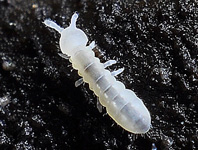Abstract
The Australian insect fauna is among the least-well studied in the world, and conservative estimates state that 75% of the species still await description. In the more species-rich groups, this percentage might be even larger, which is certainly the case in parasitoid wasps which have received very little attention by taxonomists. The genus Pristomerus of the family Ichneumonidae is distributed worldwide, with most species found in the tropics. Its members attack concealed larvae of small Lepidoptera, and several species are used in biocontrol. Five species have been reported from Australia, all of them endemic, but many more undescribed species are present in various collections.
I here revise Australian Pristomerus, focussing on the species that bear a tooth on the ventral side of the hind femur. Twenty-two species are recorded, 19 of which are described as new: Pristomerus australiensis n. sp., P. bertschmanni n. sp., P. callitrinus n. sp., P. dundeei n. sp., P. flavicephalus n. sp., P. fourecksensis n. sp., P. gracilis n. sp., P. kakaduensis n. sp., P. laetus n. sp., P. luculentus n. sp., P. lunatus n. sp., P. mangiferus n. sp., P. merus n. sp., P. nedkellyi n. sp., P. pellicius n. sp., P. periculosus n. sp., P. stellatus n. sp., P. tenebrosus n. sp., and P. venustus n. sp. A dichotomous key and an online interactive key to the known Australian species with a tooth on the hind femur are provided, including photographs of all the species.
The origin of the considerable number of Australian Pristomerus species remains unclear. They might represent Southern relict elements with affinities to South American taxa, or their ancestors might have immigrated from the Paleotropics in more recent times; this question can only be solved with a dated phylogeny of the genus. However, support for a Palaeotropic origin of at least a good portion of the taxa comes from their current distribution, as the Australian Pristomerus are found to be most diverse in the tropical habitats of Northern Queensland and the Northern Territories.
References
Austin, A.D., Yeates, D.K., Cassis, G., Fletcher, M.J., La Salle, J., Lawrence, J.F., McQuillan, P.B., Mound, L.A., Bickel, D.J., Gullan, P.J., Hales, D.F. & Taylor, G.S. (2004) Insects 'down under'—diversity, endemism and evolution of the Australian insect fauna: examples from selected orders. Australian Journal of Entomology, 43, 216–234.
http://dx.doi.org/10.1111/j.1326-6756.2004.00448.xGauld, I.D. (1984) An introduction to the Ichneumonidae of Australia. Volume Publication No. 895. British Museum (Natural History), London, 413 pp.
Girault, A.A. (1925a) An essay on when a fly is lovable, the ceremony of baptizing some and unlovely hate. Privately published, Brisbane, 2 pp.
Girault, A.A. (1925b) Records and distributions of Australian Ophioninae (Ichneumon-flies). Queensland Agricultural Journal, 24, 538–541.
Girault, A.A. (1933) Some beauties inhabitant not of commerical boudoirs but of nature's bosom, notably new insects. Privately published, Brisbane, 5 pp.
Kasparyan, D.R. & Humala, A.E. (1995) A new genus and htree new species of ichneumonids of hte subfamily Oxytorinae (Hymenoptera, Ichneumonidae) from Baltic amber. Entomological Review, 75, 71–74.
Klopfstein, S. (2014) Revision of the Western Palaearctic Diplazontinae (Hymenoptera, Ichneumonidae). Zootaxa, 3801 (1), 1–143.
http://dx.doi.org/10.11646/zootaxa.3801.1.1Klopfstein, S. (2016) Nine new species of Dimophora from Australia (Hymenoptera: Ichneumonidae): new insights on the distribution of a poorly known genus of parasitoid wasps. Austral Entomology, 55, 185–207.
http://dx.doi.org/10.1111/aen.12166Klopfstein, S., Vilhelmsen, L., Heraty, J.M., Sharkey, M.J. & Ronquist, F. (2013) The hymenopteran tree of life: evidence from protein-coding genes and objectively aligned ribosomal data. PLoS ONE, 8, e69344.
http://dx.doi.org/10.1371/journal.pone.0069344Kopylov, D.S. (2009) A new subfamily of ichneumons from the lower Cretaceous of Transbaikalia and Mongolia (Insecta: Hymenoptera: Ichneumonidae). (in Russian). Paleontologicheskii Zhurnal, 1, 76–85.
Kopylov, D.S. (2010) A new subfamily of ichneumon wasps (Insecta: Hymenoptera: Ichneumonidae) from the Upper Cretaceous of the Russian Far East. Paleontological Journal, 4, 59–69.
http://dx.doi.org/10.1134/s003103011004009xKusigemati, K. (1984) Some Cremastinae of South East Asia, with descriptions of three new species (Hymenoptera: Ichneumonidae). Memoirs of the Kagoshima University, Research Center for the South Pacific, 5, 1–9.
Kusigemati, K. (1985) Records of eight species of Ichneumonidae (Hymenoptera) from Fiji and Solomon Islands, with descriptions of two new species. Kagoshima University Research Center for the South Pacific, Occasional Papers, 5, 65–73.
Murphy, N.P., Banks, J.C., Whitfield, J.B. & Austin, A.D. (2008) Phylogeny of the parasitic microgastroid subfamilies (Hymenoptera: Braconidae) based on sequence data from seven genes, with an improved time estimate of the origin of the lineage. Molecular Phylogenetics and Evolution, 47, 378–395.
http://dx.doi.org/10.1016/j.ympev.2008.01.022Quicke, D.L.J. (2012) We know too little about parasitoid wasp distributions to draw any conclusions about latitudinal trends in species richness, body size and biology. PLoS ONE, 7, e32101.
http://dx.doi.org/10.1371/journal.pone.0032101R Core Team (2014) R: A language and environment for statistical computing. R Foundation for Statistical Computing, Vienna, Austria.
Ronquist, F., Klopfstein, S., Vilhelmsen, L., Schulmeister, S., Murray, D.L. & Rasnitsyn, A.P. (2012) A total-evidence approach to dating with fossils, applied to the early radiation of the Hymenoptera. Systematic Biology, 61, 973–999.
http://dx.doi.org/10.1093/sysbio/sys058Szépligeti, G. (1906) Neue exotische Ichneumonidaen aus der Sammlung des Ungarischen National Museums. Annales Musei Nationalis Hungarici, 4, 119–156.
Theobald, N. (1937) Les insectes fossiles des terrains Oligocenes de France. In: Theobald, N. (Ed.), Insectes fossiles des Terrains Oligocene. Imprimeria Georges Thomas, Nancy, pp. 473.
Townes, H.K. (1971) The genera of Ichneumonidae, Part 4. Memoirs of the American Entomological Institute, 17, 1–372.
Vignes-Lebbe, R., Chesselet, P. & Diep Thi, M.-H. (2016) Xper3: new tools for collaborating, training and transmitting knowledge on botanical phenotypes. In: Rakotoarisoa, N.R., Blackmore, S. & Riera, B. (Eds.), Botanists of the twenty-first century: roles, challenges and opportunities. UNESCO, Paris, pp. 228–239.
Wahl, D.B. (1993) Key to subfamilies of Holarctic and Neotropical Ichneumonidae. In: Goulet, H. & Huber, J.T. (Eds), Hymenoptera of the world: An identification guide to families. Agriculture Canada, Ottawa, pp. 396–509.
Yu, D.S., Van Achterberg, C. & Horstmann, K. (2012) Taxapad 2012. Ichneumonoidea 2011. Ottawa, Ontario, Canada. Database on flash-drive. Available from : http://www.taxapad.com (Accessed 14 Sept. 2016)

